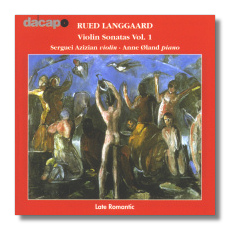
The Internet's Premier Classical Music Source
Related Links
- Latest Reviews
- More Reviews
-
By Composer
-
Collections
DVD & Blu-ray
Books
Concert Reviews
Articles/Interviews
Software
Audio
Search Amazon
Recommended Links
Site News
 CD Review
CD Review
Rued Langgaard

Violin Sonatas, Volume 1
- Sonata for Violin #1 "Viole"
- Sonata for Violin #2 "Den store Mester kommer"
Serguei Azizian, violin
Anne Øland, piano
Da Capo 8.224153 DDD 65:04
The life of Danish composer Rued Langgaard (1893-1952) can be divided into three artistic periods. In the first, which lasted until the mid-1920s, the composer tried to integrate his admiration for the Late Romantic tradition – Carl Nielsen was a strong influence – with a more iconoclastic style. This met with little favor in Denmark, and the composer had to go to the European mainland to receive at least some measure of approval. Then, in the mid-1920s, he lost patience and spoke out against the stuffy contemporary Danish music scene, rejected Nielsen, and retreated into a style more characteristic of a half-century earlier, albeit retaining quirks of his own. Denmark's response was to snub him even more. Finally, after years of searching and insecurity, he secured a permanent position as a regional cathedral organist in 1940, and entered his last period. His late works are characterized by their uncompromising stance and their almost bitter humor. Langgaard has been described as a Late Romantic composer, but given the above narrative, one can gather that such a description is a bit simplistic.
These two sonatas come from his first period. The First Sonata, written in 1915 but revised in 1945, is juvenilia, but attractive nonetheless. The meaning of its subtitle is not altogether clear; Langgaard suggested (impractically) that the work also could be played on the viola, and it is possible that he was simply alluding to the dark colors required of the violinist. The sonata is in the traditional four movements, and has an appealingly Brahmsian character, with plenty of drama and contrast. The themes are strong and the composer's treatment of them is imaginative.
The Second Sonata (1920-21) is much more unusual. It is in one movement, but tempo changes are frequent, and the feeling of cinematic "jump cuts" runs throughout its 26-minute length. The title can be translated as "the great Master cometh." This, in fact, is a Danish hymn derived from the Song of Solomon, but apparently it was Langgaard's intention to complement, in music, a "new religious world order" (in the words of the annotator). Quoting Goethe, Langgaard commented that the phrase "Nemo contra deum nisi Deus ipse" (No one against God but God Himself) could be applied to this sonata. In this work, Langgaard shows his indebtedness to Nielsen, but there is a different voice here too – visionary, mystical, uncompromising - and it belongs to no one else than Langgaard. Not that their works sound similar, but when one hears this music and reads about Langgaard's life, the American composers Ives and Ruggles come to mind. I can imagine a shared audience for their compositions.
These performances were recorded in 1999. Azizian is Armenian-born, and has lived in Denmark since the mid-1990s. (He now teaches at the Royal Danish Academy of Music.) Øland trained at that same institution, and now she lectures there as well. Their performances are strong and pithy; they dig into Langgaard's unusual ideas with gusto. Azizian's tone is somewhat wiry, but in the long run, I don't find it unpleasant, or inappropriate for the music. The engineering is excellent, and the booklet note is most helpful. Newcomers to Langgaard might want to start with one of the symphonies (Nos. 4, 6, and 10 are particularly important), but these sonatas are well worth exploring.
Copyright © 2002, Raymond Tuttle


















